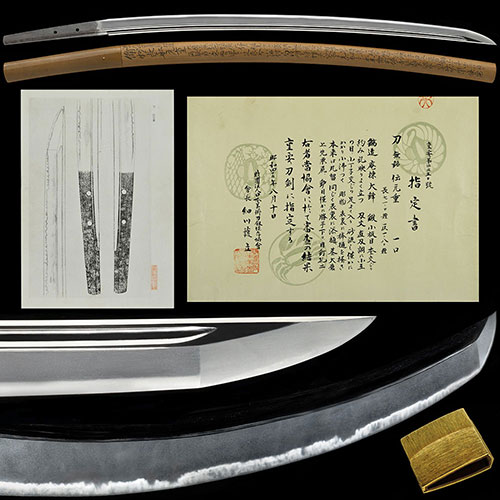
元重 刀 Motoshige Katana
No.231354元重 畠田守家孫 乱れ映り立ち小丁子小乱れ逆足葉頻りに入り金筋砂流し掛る傑作 二尺三寸五分Motoshige, Grandson of Hatakedanokami, Midare-Utsuritachi, Small-Chouji, Small-Midare, Gyaku-Ashi and You entered frequently, Kinsuji and Sunagashi-kakaru, A masterpiece 71.1cm
- 極めKiwame
- 元重Motoshige
- 登録証Registration
- 岡山県 Okayama 昭和45年9月27日 9/27/45(Showa)
- 時代Period
- 南北朝延文頃Nanbokucho period, around Enbun period
- 法量Size
-
刃長 71.1cm (二尺三寸五分) 反り 1.7cm
元幅 3.1cm 先幅 2.4cm 元重 0.69cm 鎬厚 0.72cm 先重 0.53cm 鋒長 5.9cm 茎長 19.4cm 重量 750gHachou 71.1cm (二尺三寸五分) Sori 1.7cm
Moto-Haba 3.1cm Saki-Haba 2.4cm Moto-Kasane 0.69cm Shinogi-Thikess 0.72cm Saki-Kasane 0.53cm Kissaki-Chou 5.9cm Nakago-Chou 19.4cm Weight 750g - 国Country
- 備前Bizen
- 姿Shape
- 鎬造、庵棟、身幅広く、腰反り付き、大鋒。Shinogidukuri, Iorimune, Wide Mihaba, Koshizori-tsuki, Oh-Kissaki.
- 鍛Kitae
- 板目肌に、杢目肌交じり、地沸微塵につき、地景細かく入り、乱れ映り立つ。Itamehada, Mixed Mokumehada, Jinie entered finely, Chikei entered finely, Midare-Utsuritatsu.
- 刃文Hamon
- 直刃調に、小丁子・小互の目・角張る刃など交じり、逆掛り、足・葉頻りにかかり、小沸深くつき、金筋掛る。Suguha-style, Small-Chouji, Small-Gunome, There are some angular blades. Sakagakari, There are Ashi and You frequently, Small-Nie entered deeply, Kinsuji-kakaru.
- 帽子Boushi
- 浅く乱れ込んで小丸。Shallow Midarekonde-Komaru
- 茎Nakago
- 大磨上、先栗尻、鑢目勝手下り、目釘孔二。Ohsuriage, Sakikurijiri, Yasurime-kattesagari, Mekugiana are two(2).
- ハバキHabaki
- 金着二重。Double Kinkise
- 説明Drscription
- 元重は、畠田守家の孫で、長光の娘婿守重の弟、重真の兄と伝え、年紀作は鎌倉末期正和から南北朝時代貞治頃までの60年間にわたる。最上大業物、貞宗三哲にも名を連ねる名工で作風は景光に似ている。この刀は、身幅広く、腰反り付き、大鋒となる延文貞治の豪快な姿を呈し、板目肌つみ、杢目肌交じり、乱れ映り立ち地沸微塵につく地鉄に、小丁子に、小互の目・角張った刃など交え、逆掛かった足・葉など頻りに入り、小沸深くつき、金筋砂流し掛り、匂口明るく冴える傑作である。Motoshige was the grandson of Hatakeda Moriie, the younger brother of Nagamitsu's son-in-law Morishige, and the older brother of Shigezane, and his works span a 60-year period from the end of the Kamakura period to around the time of Jouji during the Nanboku-cho period.
He is a master craftsman who is also listed in the Saijo-Ohwazamono and Sadamune Santetsu, and his style is similar to that of Kagemitsu.
This sword has wide Mihaba, Koshizori-tsuki, It displays the dynamic form of the Enbun/Jouji period that became Oh-Kissaki. Itamehada, Mixed Mokumehada, Midare-Utsuritachi with finely Jinie-tsuku Jigane, Small-Chouji, Small-Gunome, There are some angular blades. Sakagakatta-Ashi and You entered frequently, Small-Nie entered deeply, Kinsuji and Sunagashi-kakari, Nioikuchi is bright and clear, A masterpiece.


